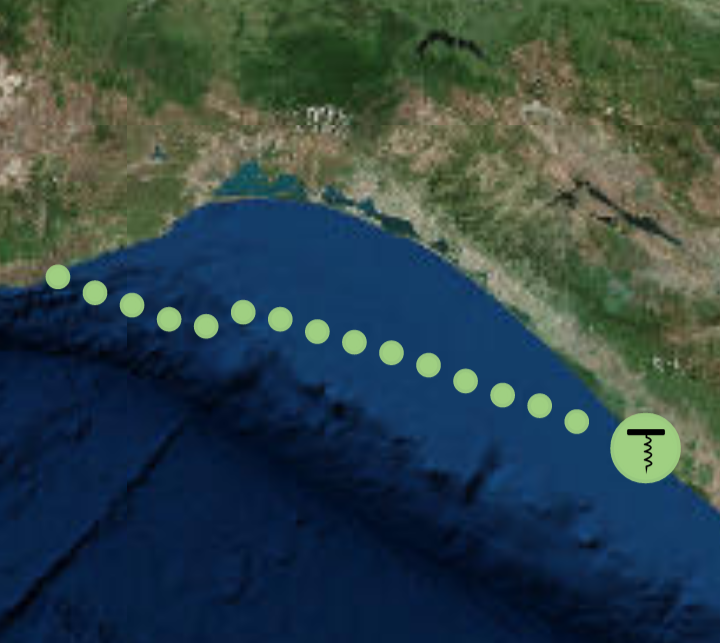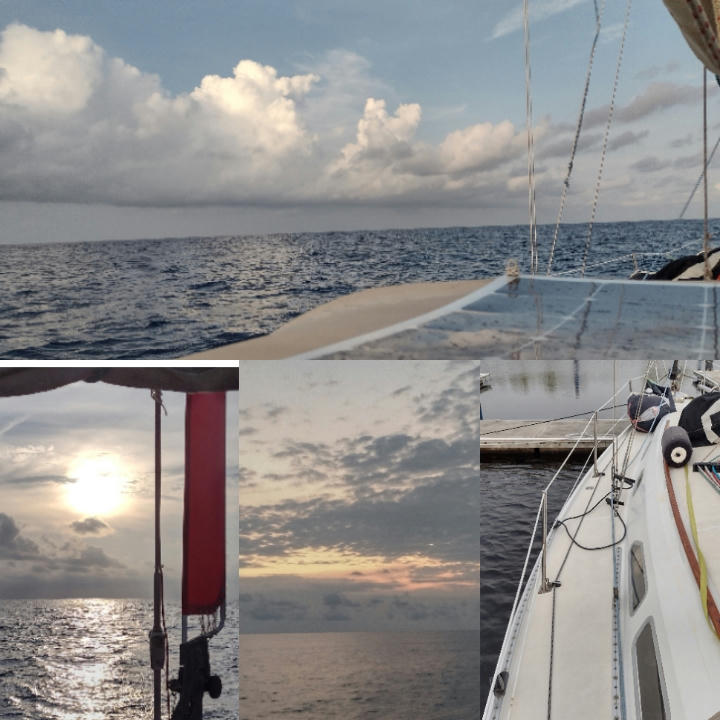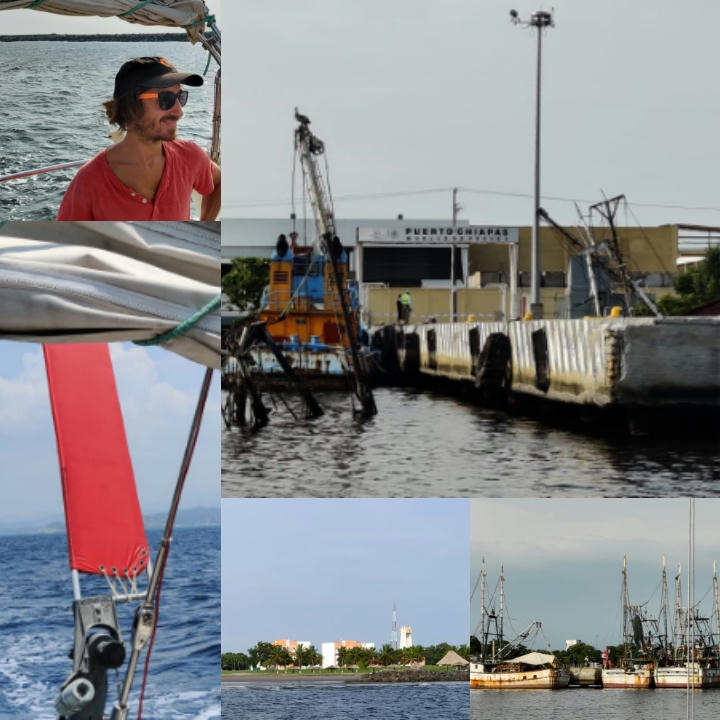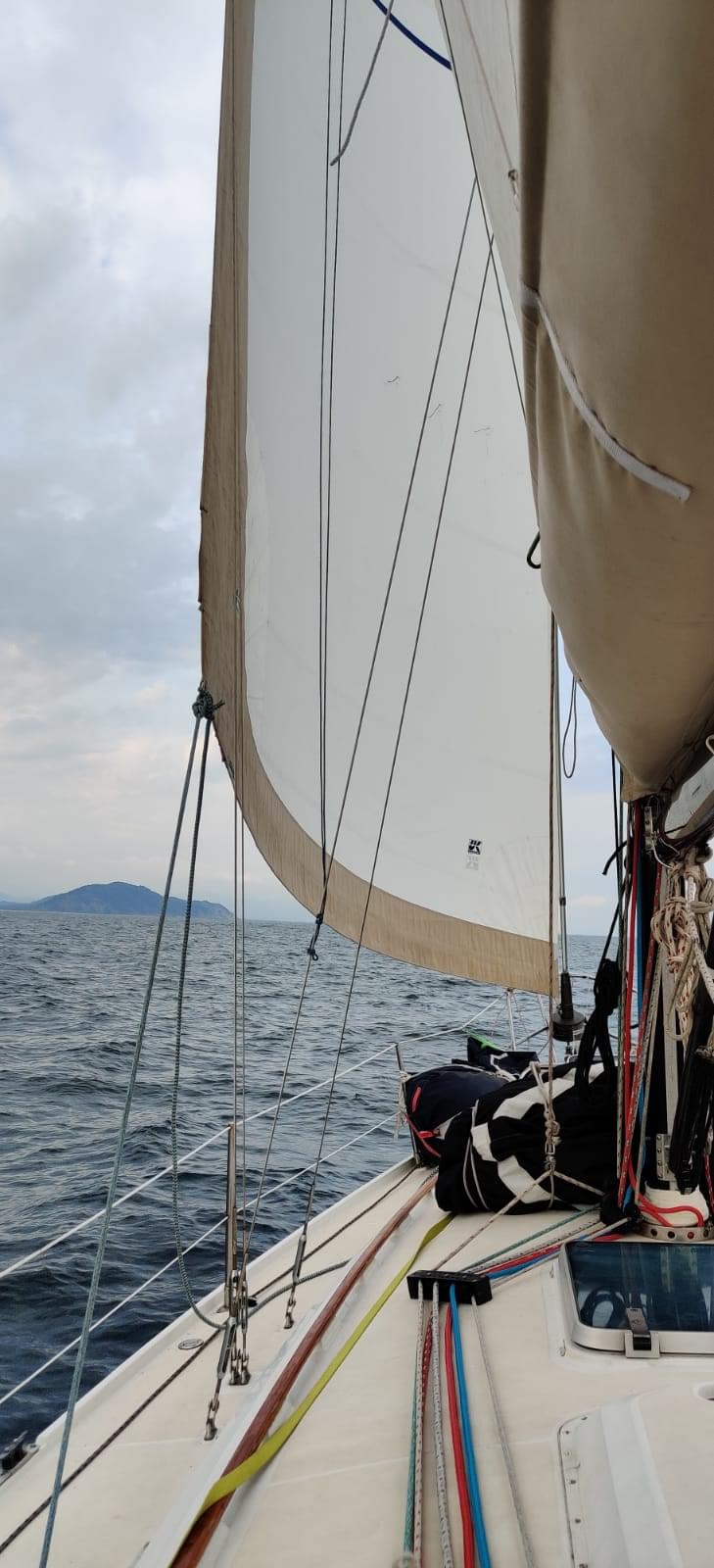Hello blog, it's been a while...
The times have been quite busy for us... sailing. And right, we are always sailing and that's the whole point, but this time, it was quite different in its (almost) stressful own way. We left you with a note of our unlucky adventures, and luckily things have been good with the boat since then. However, we still had miles to go to exit Mexico promptly. Not that we got bored of the country or anything, in fact, quite the opposite! First, since May 15th, we are officially in hurricane zone. If that sounds scary, it partially is. In reality, the beginning of the season is the least active and we are almost out of the woods, but still (as I'm writing, tropical storm Bianca is passing South of the Baja peninsula and the first letter B indicates it's the second named storm of the season already), if the routine of checking the hurricane forecast has always been reassuring, no point in pushing our chance too much and better getting down to safe Costa Rica. Second reason, we have an appointment in Costa Rica precisely, at the end of June, with our friends from Berkeley. If that's gonna be a good chance to cruise with them, chill, relax and explore all together, we still have shit-ton of miles to get there, so we'd better get going! A total of 1090 miles to get to the Puerto Chiapas in Mexico, right by the border with Guatemala and a last (but not least!) 450 nm passage along the coast of Guatemala, El Salvador, Honduras (almost no coast really, just a bay) and Nicaragua - this is going to be our longest passage so far!
But first things first:
Yelapa to Chamela - 90 nm
We had left things with a starter motor repair and our Monsieur Engine finally firing up on demand. Timing imposed that we'd sail (or actually motored) in the night to reach the next suitable anchorage. With that in mind, we decided to push a little further and reach the anchorage of Chamela that looked beautiful on picture. We arrived the morning after an uneventful trip (a welcome break), dropped anchor not far from the entrance of the river, finally able to rest! We spent most of the afternoon wondering whether we wanted to go to shore or not. I believe part of us was still reluctant after our bad experience in Yelapa, but part of us was excited to discover a jazzy town that had an easy way to disembark. The will to rest, the laziness to inflate the dinghy and simply the will to be home won the battle in favor of spending some time in the cockpit and looking at Chamela from afar. This large Bay with some sparse buildings on the beach and cars driving in the sand reminded us of Bahia Tortuga on the Baja peninsula, a milestone so long ago. The next day after the afternoon breeze started we'd keep our journey going, direction Tenecatita.
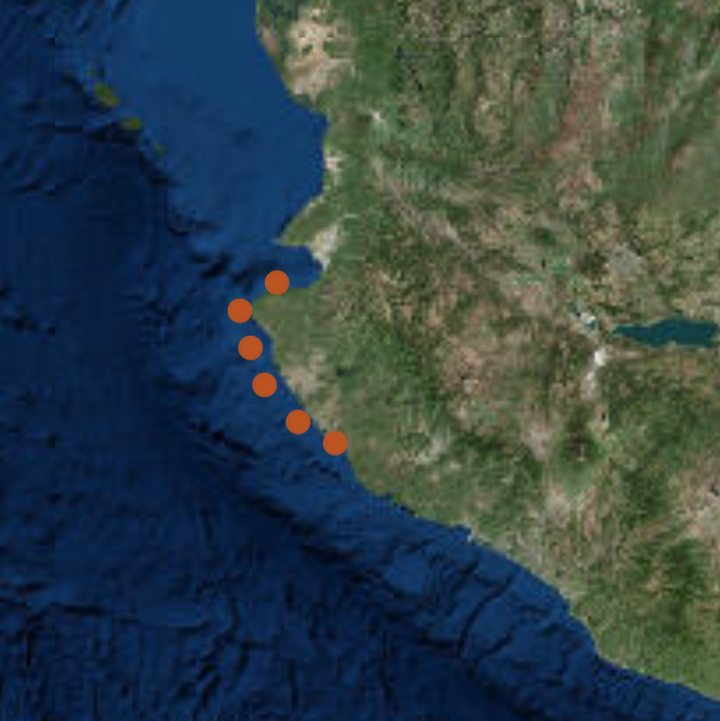
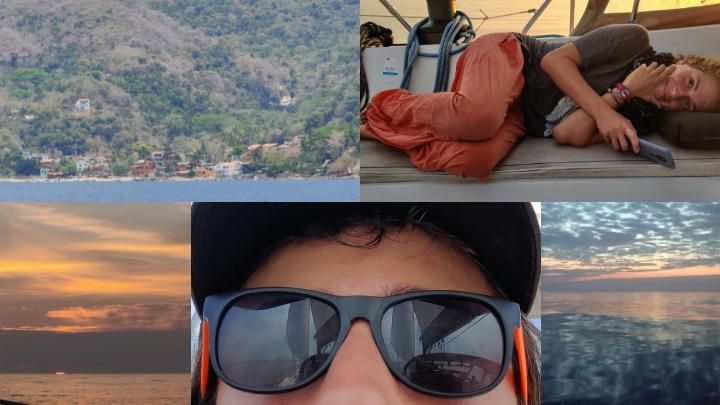
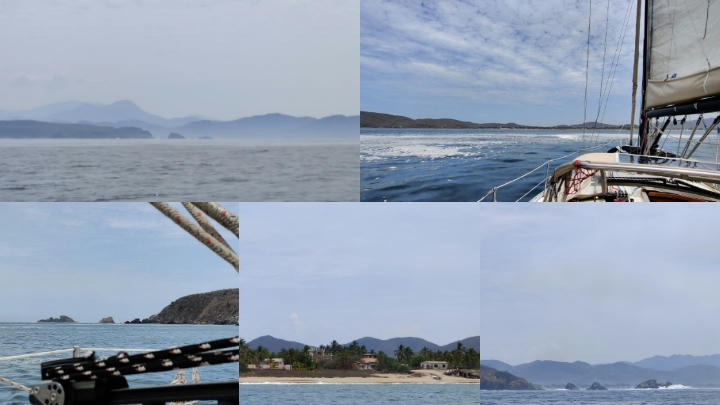
Chamela to Tenecatita - 30 nm
This stretch of coast is called the Costaalegre, which means the 'happy coast' eluding to all the pretty anchorages it shelters. Looking at the guidebook in Chamela, we had made impossible plans to try to explore a couple at least, even if it would mean waking up early and anchoring here and there for only a couple hours. Given the general absence of wind along that stretch of coast, we went reasonable though and, trying to make progress towards our new goal (Barra de Navidad), we decided to sail straight to Bahia Tenecatita. Making the most out of the afternoon breeze, we reached our destination during the night. The bay revealed itself as we passed by the rocks at the entrance. Thunder on land was lighting up a cloud heavy sky periodically. Another boat was anchored in the bay. They turned on their AIS as we set our anchor. It didn't hold the first time, so we decided to reset even further away from them on the second trial. In the morning, we discovered a gorgeous beach with palm trees, surf breaks and a cliff and hotel on the right. With the still cloudy sky, the sight was powerful. No hesitation about going to shore this time, we knew we wanted to close the 15ish nm to Barra de Navidad within the day.
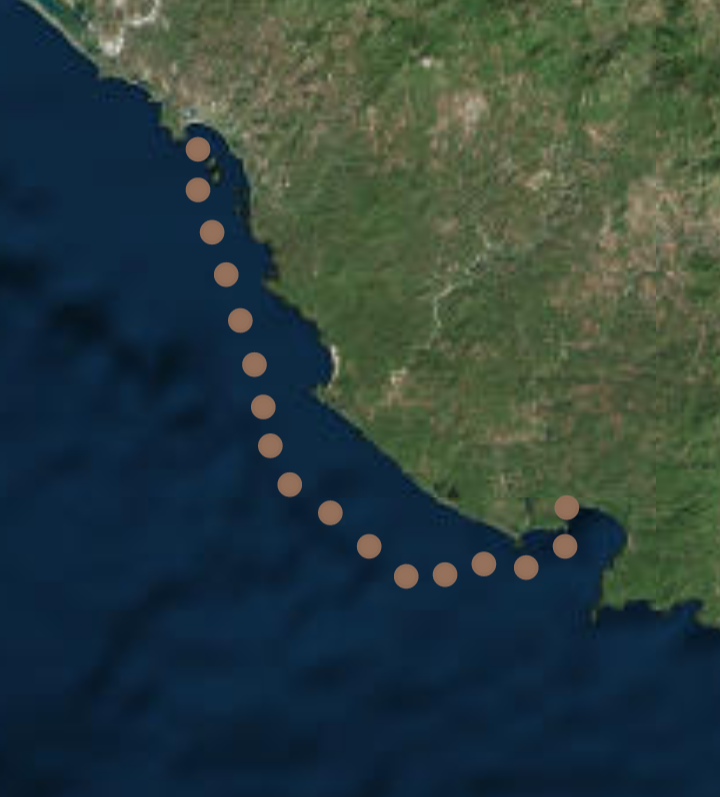
Tenecatita to Barra de Navidad - 17 nm
The distance was short, yet, a lot happened. Around noon, when the breeze started, waves started to build up uncomfortably, rocking Tirb as the surf started breaking closer and closer to us. No need to wait in such conditions, that's the signal for us that there's wind and it's time to carry on. As we weighed anchor, the other boat, which turned out to be a beautiful trimaran (big up to Shazam!), beat us to the start, jib only and we believe, single-handed. Despite the hit in our racer pride, we enjoyed beating up out of Bahia Tenecatita, knowing the sail would be short today and finally feeling the wind on our faces, and it was windy, in the mid-teens I would say. Windy enough for Yalçın's hat to fly away as he was poking his head outside the dodger. Yalçın's Pure Storage hat from his internship back in 2016, a piece of anthology that we couldn't let float away, and a hell of a chance to practice our crew overboard rescue skills! It turns out a black hat is probably more difficult to get at than a person. The first attempt was quite close but not enough, likely within two arms reach (while there only ours, needless to mention the hat has no arm!), and the second attempt turned out too close: the hat simply disappeared under the boat and we weren't sure on which side to expect it and catch it. After these, we lost the hat all together, remember it was quite windy so we would get away quite fast. Yalçın, who has a gift at spotting things on the horizon, usually rays, dolphins, whales or fish but apparently also poorly contrasted hats, followed back our GPS track (a good technique to remember) and we eventually retrieved the runaway! What an adventure! By now, the trimaran was out of sight but we had our excuse! The wind started dying out as we exited the bay. By the rocks that marked the exit, we got joined by dolphins which offered us one of the best show so far. One of them would even zigzag in front of our bow or do 360s, possibly curious to look at us. After a long and marvelous moment of play between Tire-Bouchon and his mammal friends, they left us or we left their zone and we were out of Bahia Tenecatita, the trimaran back in sight, still jib only. We pretty much followed it into Bahia Melaque, as it disappeared in the entrance to Barra de Navidad. Past a first channel that started with a confusing red marker right in the middle (that you still leave to starboard), we entered the enclosure. To our left, the basin of Barra de Navidad, with countless pangas going back and forth, restaurants on the water and even a little beach. On our right, the luxurious hotel with its private beaches that also hosts the marina. But our destination was past both, to the lagoon. Apparently a hurricane hole, this is a favorite for cruisers. The flat waters of the lagoon offer a welcome break from the swells encountered in the nearby anchorages and cruiser-friendly admenities like water taxis and even a French bakery delivery in the morning. As you can imagine, I was sold by the latter and Yalçın had made a point in building up my enthusiasm by noticing that French bakeries would be lovely for our last couple breakfasts. That all sounds perfect, doesn't it? But first, we had to enter this heavenly lagoon. And that part was far from heavenly. Lagoons are not exactly renouned for their deep waters and this one was no exception. Once in it, we would have 10 feet of water or so to anchor, that's a few feet under our keel, which is good. The arrival though would be more complex as we would have to pass a sandbar. In theory, there is a passage just deep enough for Tirb to go through, but, in practice, the channel is not marked by any buoy, so it's trial and error: make progress and if the depth sounder indicates a drop, put the motor in reverse and try another direction. We did leave some keel paint on the mud/sand of the lagoon channel (inspection while cleaning the hull doesn't lie) as we grounded a couple of times more or less sharply in the (luckily) soft bottom. Eventually, with a great help of Navionics as always and a real team effort, we manage to make our way through to the lagoon. We were greated by two fellow sailors in a San Francisco based boat (small world) who must have followed our bouncing back and forth! We left enough berth to the five or so boats anchored in the lagoon and dropped our chain in the shallowest, and likely most protected, place we have ever anchored. The trimaran of Tenecatita was anchored a little further in, in a secondary cove, probably inaccessible to us long keel monomarans (as would say Jeanet).
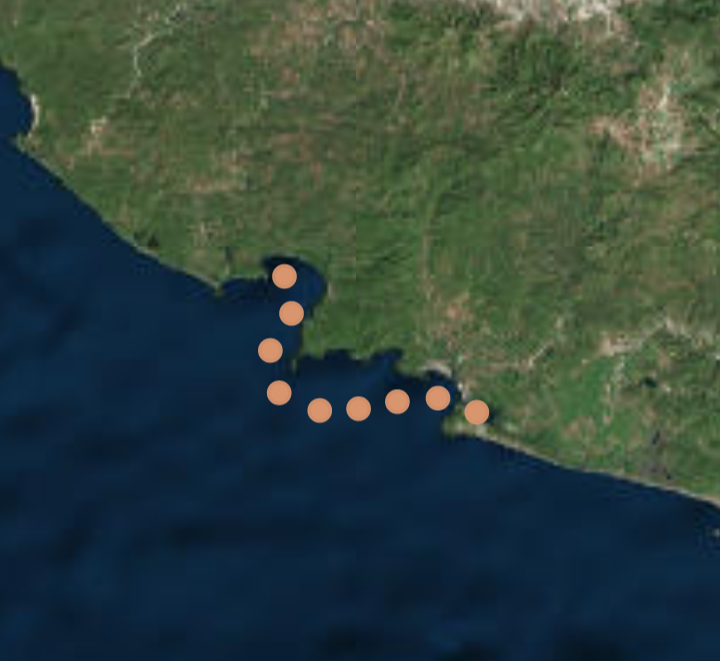
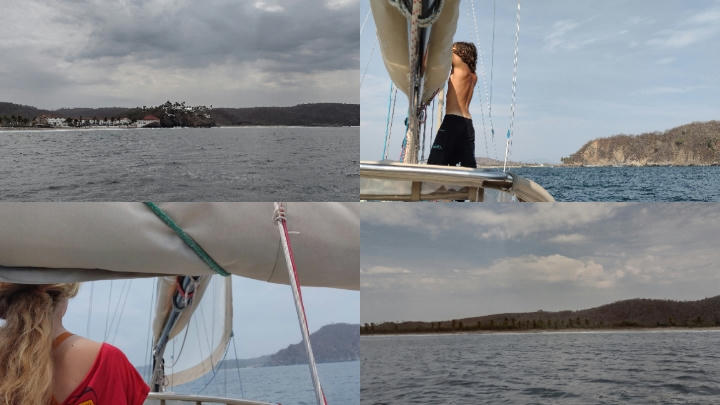
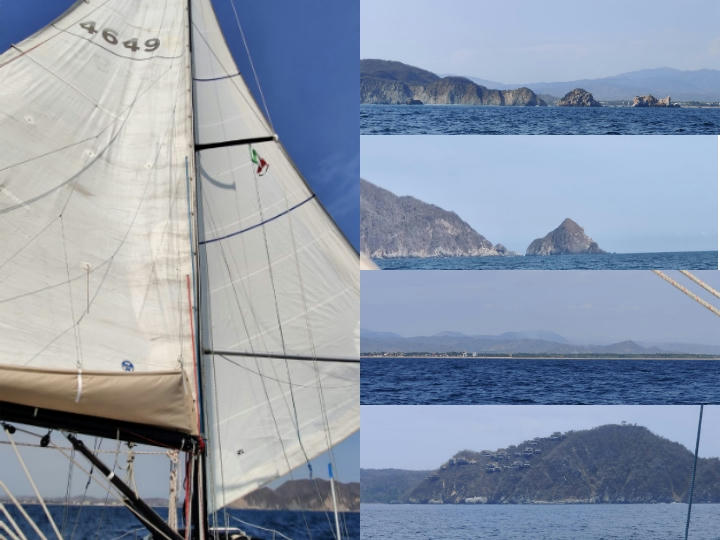
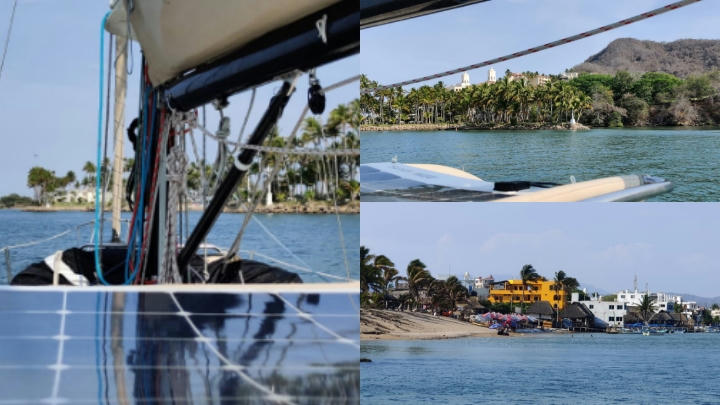
Barra de Navidad to Zihuatanejo - 222 miles
After a full day in Barra de Navidad that involved discovering the new French baker doesn't deliver in the lagoon off season (we still would get pastries but the dream was broken), a longer than expected kayak ride to the town, some fun time watching the huge waves break steeply on the beach and some work in a cafe, without forgetting some Mexican food, we had to hit the road again. There was decent wind in the forecast, in particular in the morning (a welcome addition to the afternoon breeze) and we couldn't afford to let our chance pass, so not without some bitterness to leave behind this cute little town and its comfortable anchorage that soon, we weighed anchor, followed our steps out of the lagoon, filled our diesel tank in the outrageously expensive fuel dock (they charge tie up fees as if there was any alternative...), we were off, bound for Zihuatanejo. Barra de Navidad was my must-go place along the way because of the (non-existing) pastery delivery, Zihuatanejo was Yalçın's. If you have seen Shawshank Redemption (if you haven't, we strongly recommend it!), it is the little Mexican fisherman's town from the picture, and not only it got the convicts dreaming, but Yalçın too. Therefore, it was a must see on our list as well and we hoped to spend a couple of days there. When we left Barra after all our errands, it was already noon (so much for the morning breeze!), we sailed out of the bay, not without shooting a picture of the impressive containership that was banging in the Eastern point. It had wrecked during one of the hurricanes years ago and offered quite an impressive sight! We made the most out of a decent afternoon breeze, but slightly after night fall, the breeze picked up and became a serious wind. With a reefed main and too much wind to carry the jib, we had once more to help Avocet the Hydrovane in her endeavor (we thought, again, that our second reef, that we hadn't tested since taking the boom down in Mazatlan, was tangled when in fact it wasn't). Yalçın, mostly was handsteering, when at some point, we went dark! And by dark, I mean that the light coming from the navigation instruments suddenly disappeared, quite annoying when you are reading gusts at 28 knots and using the wind measurements to steer and decide on the course for the night... Luckily, the GPS/chartplotter was still on, so we weren't totally blindfolded. Diagnosis time! Interestingly, the network that connects most of the instruments and the autopilot together (SeaTalkNg) was still on, so it had to be a problem on the side of the display. I would have been okay to pursue my diagnosis in daylight but Yalçın identified a loose connection under the cockpit floor in the network. Blinding light came back from the display of our instruments, yeah! Soon, they measured the drop in the wind speed and we had to motor, happy to have Auto-Nick ready to steer. To avoid burning all our pricey fuel through the night, we decided to stop in a marginal anchorage along the road. Cabeza Negra, supposedly a tall black point (black head in Spanish), offered two anchorages, one to the North and one to the South. Some houses lights on the North side made us lean towards that one for our approach in the middle of the night. We dropped the hook at around 4 AM in 40 feet of water, hoping we were clear from rocks, swells etc if our orientation was to change. The morning lights dissipated our worries, we were indeed way clear. Despite the anchorage being quite uncomfortable as we were taking the swell on the beam (for a longer stay, we'd definitely have gone for a stern anchor), it took us a while to be ready to take off. Once more, we left around noon and closed the 150 nm to Zihuatanejo. Our planning hadn't been bad, we got some wind and arrived in Zihua in time to anchor and see the sunset. After dark the entire hill light up offering a sight that mesmerized Yalçın: we had made it to this dream place!
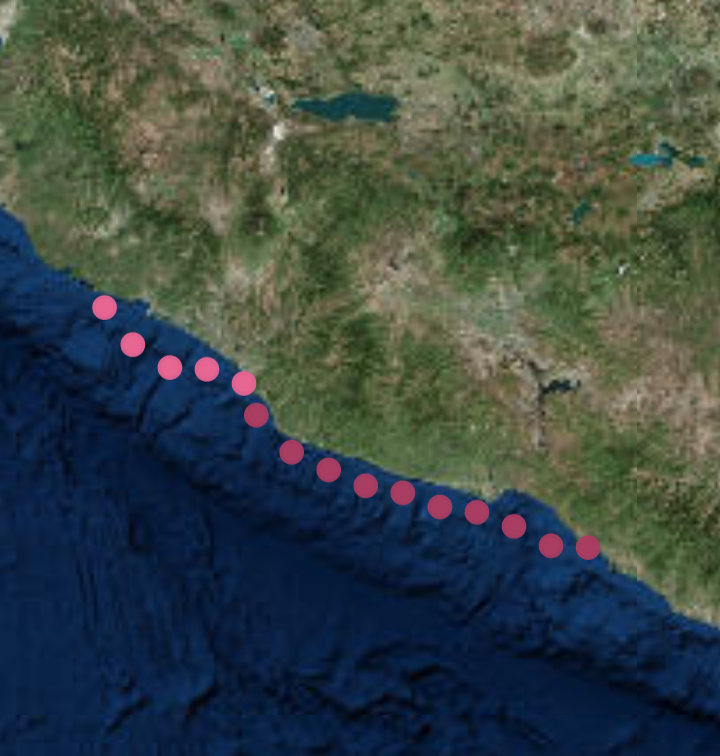
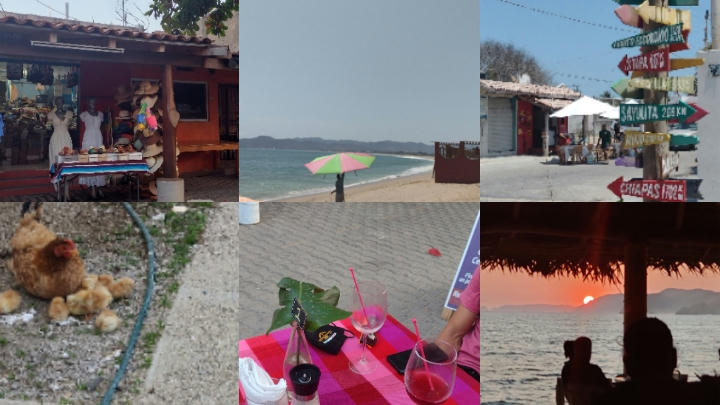
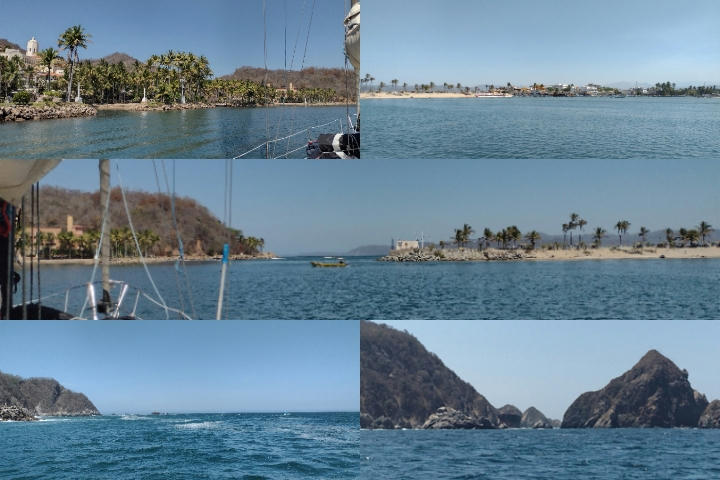
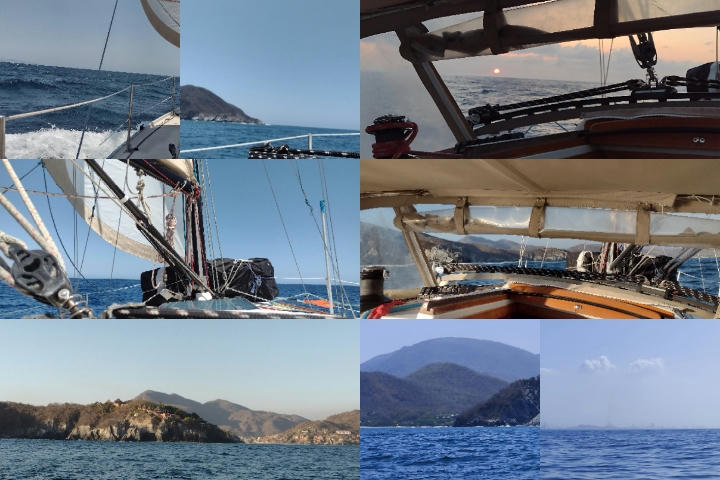
Zihuatanejo (aka Zihua), May 16th evening to May, 22nd morning
At this point, we had a long to-do of diverse things that we had to tackle (we had somewhat failed during our short layover in Barra): the usual laundry, groceries and boat endeavors, I had to prepare and carry out an interview for an article I had been writing, we were starting to seriously long for a shower and we were hoping to take a full day off to properly celebrate my 33rd birthday. Quite a program for the three days we had granted ourselves before resuming our race to the South (or East actually at this point). Needless to mention that, instead of feeling like a nice relaxing break, this layover was starting to feel more stressful than anything else. After a rough beginning, we decided to lower our expectations and simply go explore the town to find an ice cream place (our favorite land treat since we don't have a freezer onboard) for the afternoon. To add to the fun, the dinghy landing in Zihua can be challenging, with surfs, but nothing ever went wrong during our time here. Instead, it felt like we got a welcome practice at identifying the wave sets and deciding on the right time to "go for it". This first day ice cream turned out delicious, even though we walked for a while to get it, having missed the touristy street by the waterfront that had an impressive number of ice cream stores. We discovered a cute little touristic town, with lovely narrow streets, souvenir shops, a large market, and, as our guidebook noted, enough coffee shops and restaurants to feed the entire town at once! It was the low season, so the crowds were gone and I believe we would have had a different impressive during the winter. In the end, we managed to balance our tasks and relaxing meals and drinks, as well as exploring and souvenir sessions. It turned out, the town had a lot of public showers (the first time we saw this and we would see it again further South) which turned out convenient, we even managed to find a laundry place on our last day which had turned out to be an endeavor to find. We even bought to go Chinese and Mexican meals to have food ready to go underway. We were ready to attack our series of long legs: 100 nm, 250 nm, 210 nm and then the long passage to Costa Rica.
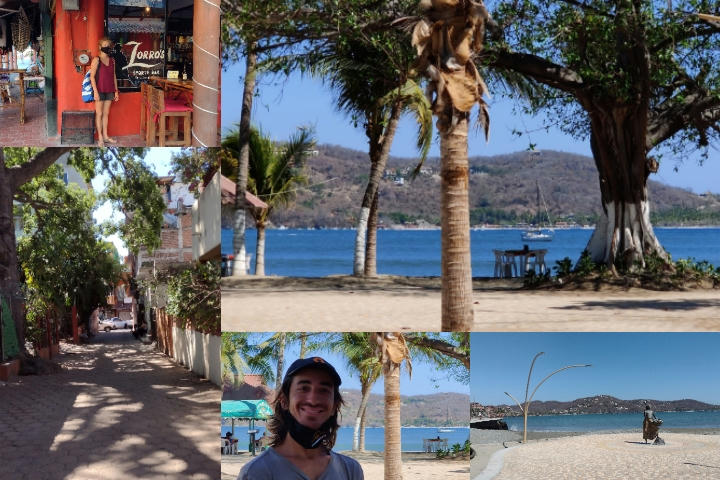
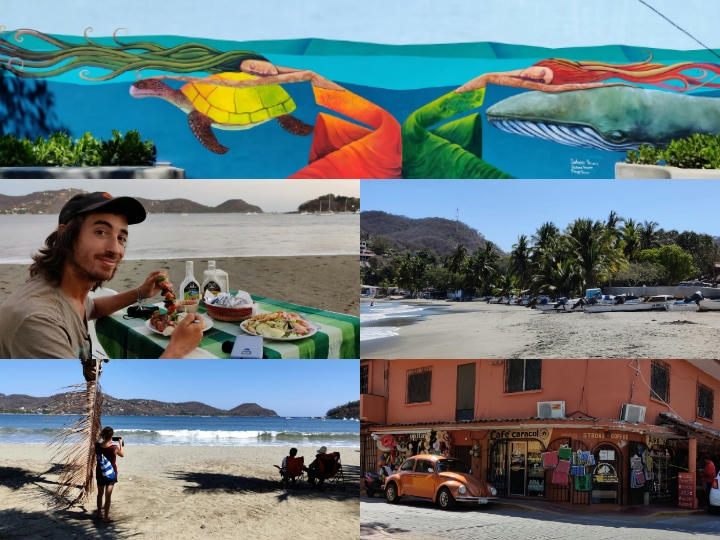
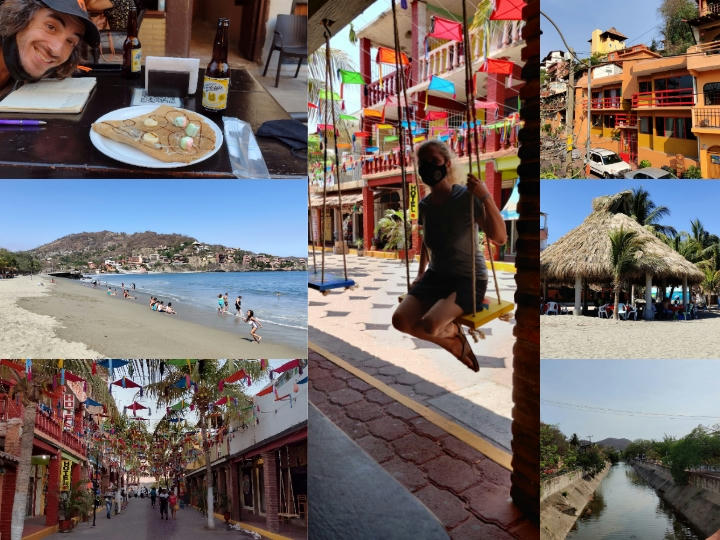
Zihuatanejo to Acapulco - 113 nm
Hull speed! What a delight to have some real winds and finally make some decent speeds. The speedometer would read between 5 and 6 knots, sometimes more. It felt like back in the old days of our sail down the Baja peninsula - we could take the wind for granted back then, sight! Sadly, the wind went down at night and, once more, we had to rely on Monsieur Engine to make progress. We motored all night and go some wind the next day in the afternoon. The tropical heat was brutal and the only way to escape it was to sometimes jump off the boat for a refreshing bath. Our consolation when the wind lightened, before turning on the engine, we would get trailed from a line at the stern of the boat in the warm waters of the Pacific.
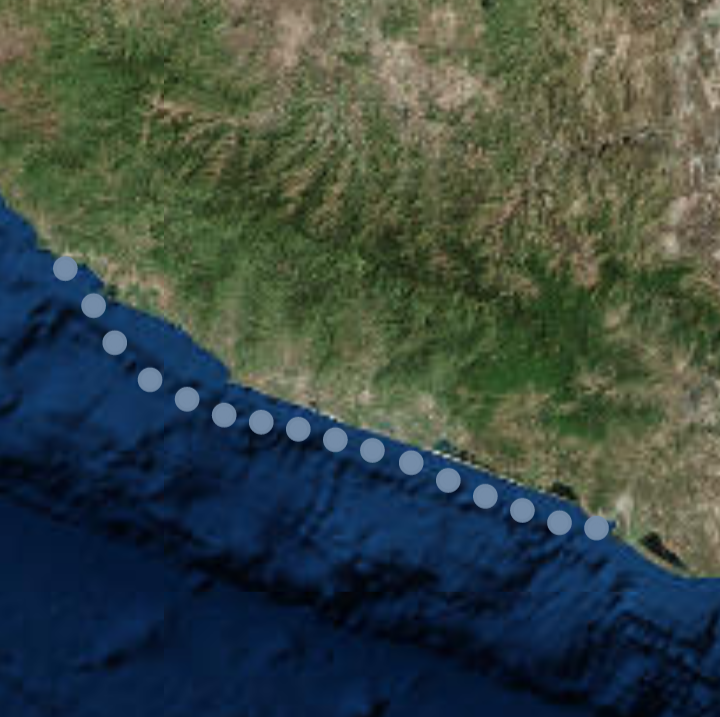
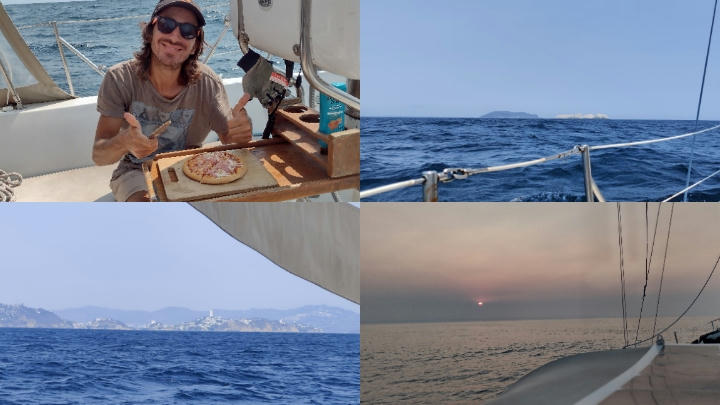
Acapulco, May 23rd evening to May 25th morning
In Acapulco, we had decided to make our lives easier and stay on the boat. That way, no complicated planning and research to see where to land the dinghy, no pressure to choose which part of the city to discover during our day in town. The famous Acapulco would remain mysterious, tied to what we'd imagine the different neighborhoods to be: the Old Town that was facing us from our anchorage in Isla de la Roqueta, the Golden district of sky high white resorts enclosing the beach and another part of town on the hill that had its dedicated anchorage and was referred to as a really poor and dirty neighborhood. We would never know more and I see some poetry in it, we are still free to imagine it as we please. Instead of a possibly challenging exploration, we chilled, cooked for the upcoming three days of navigation and cleaned the hull of the boat that had grown a proper loan seeded with barnacles. The task turned out larger than we had anticipated (as always) and was three quarter completed by the end of the day - that will still be enough to give us back our knot of speed that had vanished with all the greeneries. We hadn't gone up the mast for instance and there were still items on our list, but we were overall happy and ready for our two-night and three-day sail to the entrance of the Gulf of Tehuatepec.
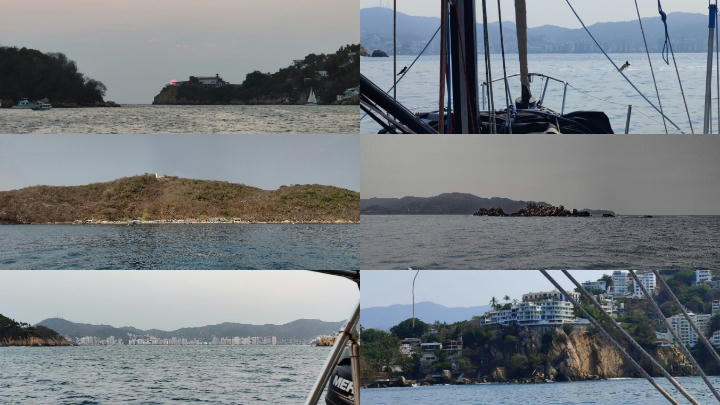
Acapulco to Huatulco - 246 nm
With this nice feeling of being refreshed and ready, the first two days of our trip went gorgeously. Nice wind, flat seas, we had started to warm up to the idea of sailing with the bimini up and the shade was a game changer, for me in particular. This, and a jump in the water each time our speed would be a little too slow, made the tropical heat more bearable. During my shift the first night, I noticed the full moon was started to be hidden, like eaten a little bit from the side. It must be a cloud, what else? But when a clear half had disappeared, there was no other explanation: it had to be an eclipse! Damn, would the bright moonlight that I was counting on for the rest of my shift disappear just like that? My complain must have been heard since soon the partial moon disappeared all together behind a cloud this time! No way to blame the eclipse this time, nor to see the rest of it, which I had found cool enough to wake up Yalçın so he could get a glimpse at it. He indeed had seen an email on the sailing club list about a moon eclipse and how they are visible from any longitude at the same time. Sadly for him, seeing a half moon disappear behind a cloud, without the progression of it, didn't look that impressive (and nor did my picture for the exact same reason: it just looked like a half moon!) and he wanted back to bed. The moon never reappeared and the sun rose. Morning dolphins came in numbers play by motoring Tirb, a gorgeous way to start the day! Even during the next night, it took a while for the moon to reappear. We had expected a full moon bright sky, instead we had a dark and cloudy sky intermittently light up by lightening. And for a sailboat and its tall mast, finding itself under a lightening storm is definitely not the best idea. As the sun set, we could see one storm on the land, with lightening strikes repeatedly hitting the top of a mountain. Impressive, but nothing to be too worried about. And there was another storm offshore, lightening half of the sky on our starboard tack. We couldn't see individual lightening nor hear the thunder (but maybe that was normal at sea, if there was nothing to reverberate and amplify the sound, who knows?). No sound meant no way to know how close the storm was to us - we would learn later that no sound means that the storm is too far for you to hear, which is a good thing! With little experience sailing in these conditions, we took our shifts and sat in the cockpit after carefully putting our most valuable electronics in the oven (the SAT phone, our cellphones with the charts and the handheld VHF radio), just in case! Our thoughts independently went from the physics of plasma, wondering if the dodger would act as a partial Faraday cage, to the realization that the idea of a superior power so dear to religions, would totally emerge from the sight of such powerful natural forces. Yalçın took the third shift, as I went to the V-berth to sleep - a welcome change of scenery compared to our usual quarter berth shift berth. Lying under the hatch, I could see the beautiful jib and part of the mainsail, enough to forget about the flashes afar and to go to sleep. Two hours later, when I emerged, Yalçın was sailing back to Puerto Escondido, the first of a series of little towns, all possible candidates for our arrival, but hopefully not in the middle of the night! We had passed the land storm for a while, but the offshore one had intensified in frequency and was now all round us, except for where the land was. Yalçın was trying to remain close to the town while waiting for a weather forecast update through their 3G. The forecast itself wasn't that insightful (nothing new) but we discovered a nice time resolved report of the location of the lightening for the past half hour: we weren't in danger zone, but would be heading into it if we kept our course. Instead of doing that, following one of the possible recommended course of action in case of lightening storm, we decided to drop anchor close to land. This would also allow us to sleep simultaneously and hopefully recharge a little faster than underway. The anchorage by the town seemed crowded with pangas and moorings according to Navionics, which was far from ideal for an arrival at night, so we decided to anchor deep (in 45-50 feet) off the beach, that spot could get some surfs but it seemed unlikely given the current conditions. We passed out for two hours, after which, the anchorage became really uncomfortable. According to the lightening report, the storm was moving offshore. Seas and wind had been building up and this location would soon become dangerous. We had to lift up anchor and fast. It was already challenging as the wind had turned around since we had set, and the bow was pounding, sometimes submerged. Our engine could barely make 2 knots in the wind. We were glad we had taken off. We set our reefed sails, remembered that we were coming from the Bay area to give us confidence in these strong conditions, and resumed our watches. As we put a reasonable distance to the shore without getting close to the storm, the seas and wind calmed down a little, to end up mild as the storm passed and the sun rose. What a relief to have made it through this night, we now had to make it to Huatulco with little wind, the only stop that would allow us to get more diesel in the area. We gave a try to sailing but the speed was variable impairing constantly the heading of the Hydrovane which steers to apparent wind. After calling the marina which insisted we arrive before sunset as the entrance is tricky, we gave in and motored all the way left to arrive by 6PM. By the entrance, which was indeed narrow but well-marked in daylight, we announced ourselves on the radio in Spanish (and it worked!) and the security guards showed us our spot on the "megayate" dock (not that we suddenly upgraded but the rest of the marina wasn't dredged and was apparently too shallow for us), by an impressive neighborhood. The docking went perfectly and we were happy to end this trip solidly tied to a dock, way more ready to take whatever storm entrées on the menu for tonight. After checking in, the roofless and pretty basic shower of the marina (the nicest view I have ever had while showering though) gave us enough energy to get diner in the Italian restaurant by the docks: a well-deserved somewhat fancy diner with wine to celebrate our arrival! This stop in Huatulco was starting well...
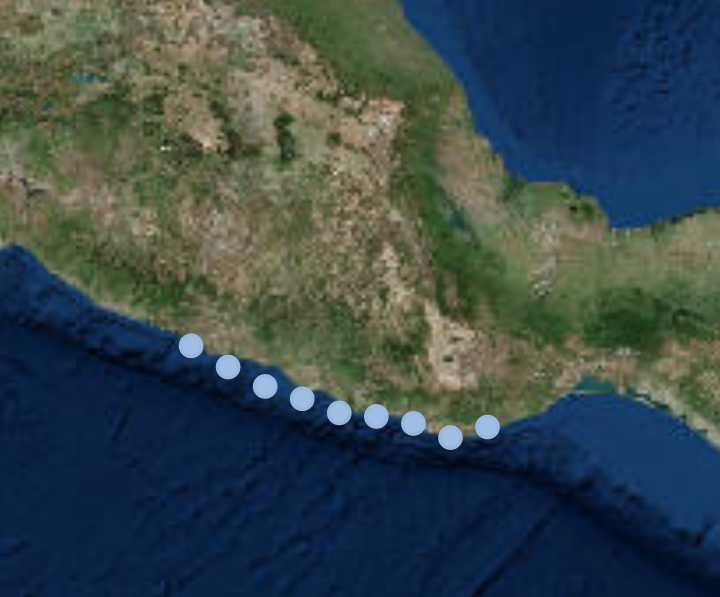
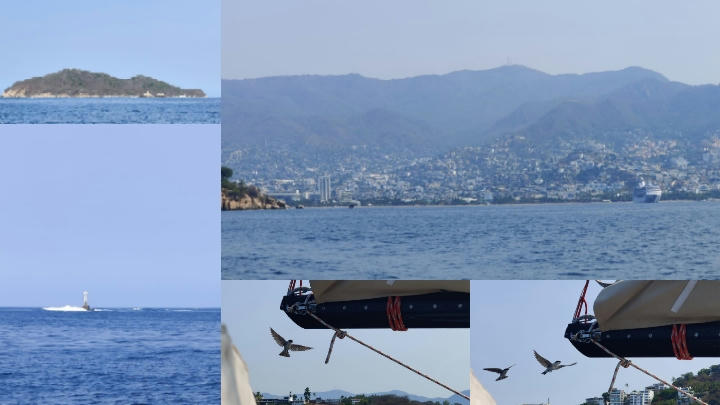
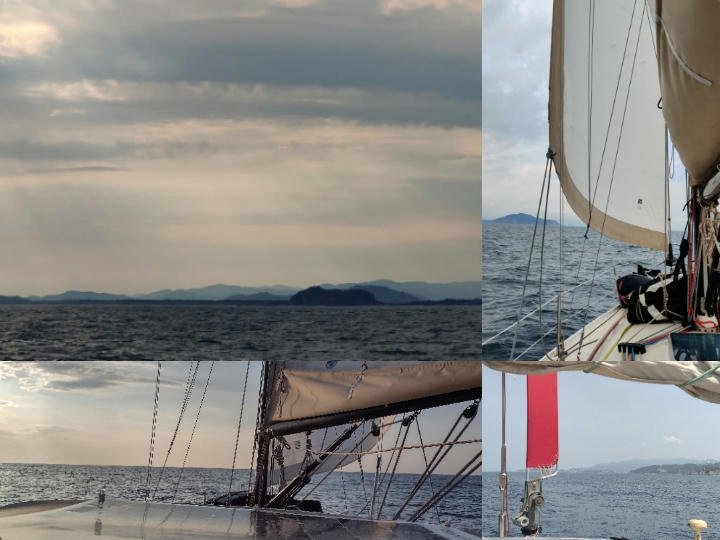
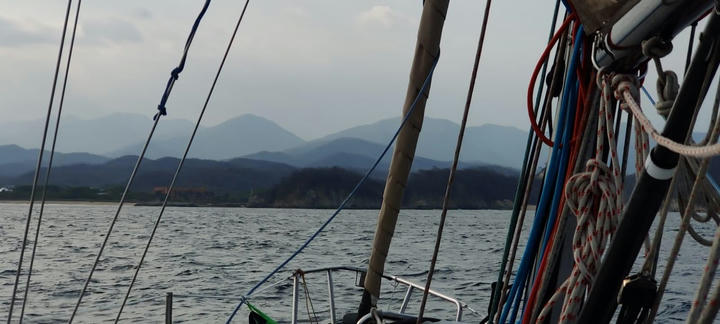
Marina Chahue (Huatulco), May 27th evening to June 2nd morning
People seemed way more attentive to paperwork around here (maybe with the proximity to the border?) and we had been mandated to also check-in ourselves with the Port Captain in town. Usually, marinas would do it for us, but we were actually curious to see how that would go, given that we would apparently have to do it everytime in Costa Rica. Also, we needed fuel and the marina fuel dock wasn't operating, leaving a non-floating dock by the Port Captain's office as the only option. It didn't look very suitable for sailboats from what we heard, we wanted to check for ourselves. We walked the twenty minutes to the other bay, examined the fuel dock which we decided also wasn't the best option (people seemed to think 80L of fuel was a small enough quantity to be taxied in jerry cans) and we checked in. The process took some time for no apparent reason but, after managing to explain that we weren't three people onboard (my names had been written on two lines and it seemed to be confusing to people, like at the marina yesterday), we came out with a new Zarpe stamped by the authorities. We would have to come back before departing, to get another stamped form. We then walked out from a restaurant on the beach where prices were outrageously expensive, to find a nice coffee shop in a back street that had delicious juego de naranja and local specialties. We devoured both the food and drinks as heat was started to take its toll. We weren't unhappy to then go do some shopping in air conditioned places, which also offered ice cream! We had to decide when to leave Marina Chahue based on a difficult weather decision: the Gulf of Tehuatepec is a 200 nm indent in the Pacific side of Mexico, this indent leaves only a narrow and low isthmus where winds cross from the Atlantic and get amplified as a very focused stream of gale force winds, bringing with them, choppy seas on a regular basis. Luckily for us those events get rare from May on. Yet, we would see remains on it on the forecast to be avoid. On the other hand, when the wind was absent, the Gulf looked like it'd get quite stormy, which was also a concern. Trying to avoid both instances as much as possible for the three day window required to make the passage, we made a tentative plan to leave on the following Wednesday. We spent our five days in the marina doing some computer work (still working on this article), refilling Tire-Bouchon fuel and water tanks as well as food lockers, and walking around for some well-deserved breaks. The off-season marina vibe was friendly. We got to know our sailboat neighbor, Juan, a single-hander from Argentina who was bringing his boat up to the Gulf of California, since French Polynesia was still closed due to Covid. He gave us a lot of contacts in Panama as well as tips on where to haul out the boat and how to get new parts or work done. In exchange, we gave him our nice guidebook of Pacific Mexico and paper charts of Baja that would like never been used by us. His truly enthusiastic personality was refreshing and made the communication possible despite our basic Spanish and his little English. Turkish seemed like too much though as he decided to rename Yalçın in Pedro instead of trying himself at the difficult pronunciation! Enrique was another character of our time here: he helped us carry the fuel from the gas station and warmed up a little when he saw we could communicate in Spanish. We took the taxi with him to get the jerry cans and pay by card directly at the gas station. Apparently, indeed 80L wasn't much as he bought another 50L for a friend's boat during the same trip. That reassured us on the quality of the transport, I had been worried about getting water or dust contaminated fuel in our tanks after horror stories to be read online. But the jerry cans were clean and we finally worked out our fuel filtering system (the opening of our tank is tilted to the side) as Enrique siphoned patiently the content into our tanks. He described a dire work situation due to Covid. Business had become quite scarce. Like usual, he was amazed that we came from very far and were planning to go home in Tirb. He warmed up even more after a little tip and recommended us his favorite restaurant in town, "and don't even look at the menu, ask for the 'comida del dia', the food of the day, it's cheap, 60 pesos and very good". He wrote down the name and location for us and would be friendly each time we'd unexpectedly run into him, at the marina or elsewhere, what had started as a business cold relationship had turned into a warm amigo-ship! Similarly, the waitress in the Italian restaurant from the first night would always give a warm greeting while setting her tables for the night. This cute little place had definitely a good vibe, but we had to carry on. On Tuesday, we went back to the Capitania Puerto, checked the "Dos Hermosas" restaurant which indeed was quite good, did an ultimate round of provisioning, paid our dues at the marina and cooked for the passage. Once again, we were ready to head out and take on the infamous Gulfo de Tehuatepec. Or at least, that's what we hoped.
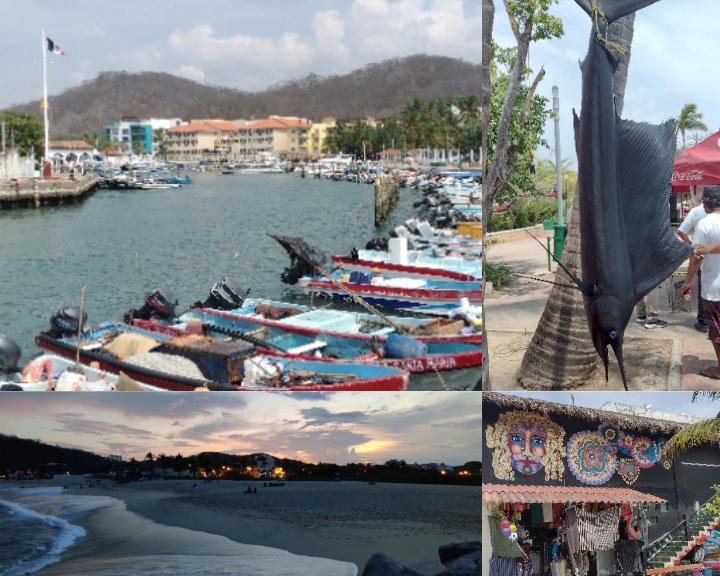

Huatulco to Puerto Chiapas - 239 nm
The Gulf of Tehuantepec lived up to its reputation and our first 24 hours were rather nerve-wracking. The Tehuantepec winds were up as we left Marina Chahue around noon. It was in the forecast and they were supposed to die out before reaching the colossal forces they are known for, but yet, the swell was up and surfs were breaking on the reefs of Bahia Chahue. This manifestation of nature forces was already humbling. We put our sails up and made the most of the rare wind we would have during our crossing - trying to minimize the Tehuantepec gap winds from the Atlantic and the storm for three days, hadn't left much room to try to optimize wind at all, and we were expecting to motor most of the way, especially since we really wanted to arrive on Friday before the stormy festivities from the forecast would begin on Chiapas. Some miles out, we crossed an impressively clear line between green waters and blue waters, I guess we were officially starting our journey in the Gulf of Tehuantepec. The seas were built up and confused, making the ride somewhat uncomfortable and forward progress quite slow as we had to turn on the engine quite soon. With such unfriendly conditions, we weren't in our best moods to start the night. Some lightening was to be expected but we weren't supposed to have reached its location yet and it was supposed to be rather mild anyway. To give you an idea, the storm offshore Puerto Escondido was rated red as lightening was very frequent, and the forecast said yellow at most for the storms on top of the Gulf of Tehuantepec, so we should be good. Right? Yet, we ran into the storm. When the sun set, we could see the flashes afar. Still not too worriesome. During Yalçın's first shift, we got hit by a squall. Quite characteristic of the tropic, it's just a rain-heavy wind-up wind-intense moment. Yalçın had seen the darkness of the rain approach slowly, it hit and it passed. But the thunder was still there. Since the squall had woken me up, we switched and Yalçın went to bed. The lightening wasn't gone though, but still flashes afar only. Until the point where... I saw a lightening! It wasn't necessarily super close but that's the first time it was visible as opposed to the sky just lightening up. That was more serious and it meant it was falling closer to us. Dang! Just in case, I woke up Yalçın. We had taken precautions and put our electronics in the Faraday cage-oven, we had battery jumper cables hanging from our shrouds and we even shut off our entire electric system at some point. In the night, we tried to sail in the direction of open sky, until it became dark itself and we would take and try to go somewhere else. For the worst of it, we stayed the both of us in the cockpit, cuddled on another holding hands in the storm. Eventually, the sun rose. The storm was still somewhat active but behind us. It looked well more benine in the sunlight. We had made it through the night! The wind eventually died and we turned on the engine would support us for the next 2 days, except for little breaks to jump in the water for refreshing purposes. We treated ourselves during the day, made sure we went back to hydrated and well fed as the night had taken a toll - on me especially. The following night was a piece of cake, in comparison to the first. We did see some flashes in the sky but we now knew they were far enough not to have to worry about them. No dark cloud really crossed our course and we were able to give ourselves sleeping times of 4 to 5 hours to rest enough. For once, the third day wasn't a total ordeal where we felt tired and ready to arrive. We were just calm and in the groove. Starting with the hardship changed the dynamics I guess. After another day under the sun, we reached Puerto Chiapas around 6PM. Upon arrival, some swell had built up, entering the break wall demanded some focus but it went smoothly. We were so happy to have made it: the last port of Mexico! It felt surreal! We announced ourselves on the radio several times, not sure when the marina would finally hear us in this hudge harbor. We never heard back but two deck people were waiting for us at the dock by two other sailboats. They welcomed us warmly and told us to wait for the inspection before being able to disembark. We had read about it: being so close to Guatemala, every boat gets boarded and searched by the marines. We had wondered how that would go. Quite soon, we were joined by friendly Port Captain and 4 marines in uniform with a dog. They introduced themselves in English and sked if we had pets onboard. Since we didn't they asked if the dog could come aboard and search. It was a big dog! The poor animal got dragged down our companion way and soon came out, after hearing the marines mention the lack of space inside. The chief officer and the Port Captain finished the paperwork, stamped everything and welcomed us once more. We had officially arrived!
